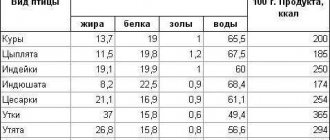Why does our body need calcium?
- to build and strengthen bones and teeth;
- to regulate muscle contractions;
- for balanced functioning of the nervous system;
- for the production of hormones;
- to regulate blood pressure and blood clotting processes.
It may seem that consuming enough calcium is necessary for skeletal and dental health, but the opposite is true. An excess amount of calcium is deposited in the teeth and bones, and first of all, the calcium that enters the body is spent on other functions listed above, and only the lack of this macroelement to provide them leads to a deterioration in the condition of the teeth and bones - the body begins to use up calcium reserves.
Interaction between iron and calcium
About the article
73597
0
Regular issues of "RMZh" No. 4 dated February 23, 2006 p. 274
Category: General articles
Author: Shikh E.V. 1 1 Federal State Budgetary Institution “Scientific Center for Expertise of Medicinal Products” of the Russian Ministry of Health, Moscow; Federal State Autonomous Educational Institution of Higher Education “First Moscow State Medical University named after. THEM. Sechenov" of the Ministry of Health of Russia (Sechenov University)
For quotation:
Shikh E.V. Interaction between iron and calcium. RMJ. 2006;4:274.
The quality of multivitamins is determined by the balance of their composition and the efficiency of absorption of biologically active components from them. All vitamins and most essential minerals play an important role in biochemical processes, interacting with other biologically active substances. They also interact with each other: during storage, during release from the dosage form, during absorption (they compete for carriers), on metabolic pathways in the body (they exhibit synergism or antagonism).
Numerous studies have shown that calcium significantly reduces the absorption of iron in the gastrointestinal tract. Antagonistic interactions between calcium and iron can be prevented by taking calcium-containing foods (milk, green vegetables) and iron-rich foods (meat, liver) separately. And when choosing vitamin and mineral preparations, preference should be given to those in which calcium and iron are separated. Mineral deficiency and ways to correct it. According to the Research Institute of Nutrition, vitamin and mineral deficiency was detected in more than 50% of the population surveyed. The reason for this is not only that the standard diet of an adult contains only about 70% of the required amount of micronutrients (54% iron, 40% vitamin C, 65% vitamin B1), but also a number of environmental and geochemical factors that worsen the situation. Thus, environmental pollution and bad habits (increased consumption of antioxidants), as well as some geochemical features (low iodine content in water), lead to the development of deficiency. Modern scientific evidence strongly suggests the possible negative consequences of vitamin and mineral deficiency. In the current conditions, the only way to prevent and treat polyhypovitaminosis and polyhypomicroelementosis is the regular intake of complex vitamin and mineral preparations. There are a large number of preparations on sale that contain an almost complete set of essential micronutrients. But sometimes it is difficult to choose a particular drug, since they have a similar composition (10-15 vitamins and vitamin-like substances, 5-15 minerals) and do not differ in release form. Moreover, substances (vitamins, metal salts) for the production of vitamin-mineral complexes are purchased from the same suppliers. All vitamins and most essential minerals enter the body in microdoses, but play an important role in biochemical processes, exhibiting their pharmacological activity by interacting with other biologically active substances. Especially often, a competitive type of interaction occurs for minerals, since they are used in the form of chemically related derivatives and use common mechanisms of transport into the internal environment. Absorption of calcium and iron in the body A summary of the physiological role and absorption of calcium and iron is presented in Table 1. Calcium is the most abundant mineral in the human body. It plays an important role in both intra- and extracellular processes: in the contractile function of cardiac and skeletal muscles, nerve conduction, regulation of enzyme activity, and the action of many hormones. It is a cofactor for the activation of a number of enzyme complexes in complex multi-stage blood clotting processes. Essential for growth and bone formation. Therefore, the need for calcium is especially high in children and pregnant women. The body of an adult male contains approximately 1200 g of calcium. 99% of this amount is concentrated in bones and teeth, the rest of calcium is distributed in intracellular and extracellular fluids. A person consumes about 1 g of calcium daily through food. In the acidic environment of the stomach, calcium salts dissociate, 20-40% of the macroelement is absorbed. The main site of absorption is the duodenum and jejunum, but some of this element is absorbed in the ileum and colon. The availability of calcium for absorption depends on many dietary factors, including the presence of phosphates, fatty acids, and phytates, which bind calcium and make it unavailable for absorption. Absorption in the intestine occurs through active transport against an electrochemical gradient, as well as through passive diffusion (when the calcium content of the food and, therefore, its concentration in the intestinal lumen increases excessively). Reabsorbed calcium is transported across the cell membrane by the vitamin D-dependent calcium-binding protein calbindin. Vitamin D promotes the synthesis of calbindin in the body, and therefore the absorption of calcium. That is why calcium supplements usually contain vitamin D. Most often in the production of food additives and vitamin-mineral complexes, calcium salts such as carbonate, gluconate, citrate and phosphate are used [2, 3]. Iron is one of the most studied and researched microelements. Iron deficiency is the most common nutritional deficiency in the world, affecting mainly children in the active growth phase and women of childbearing age. Iron requirements are determined by age, gender and physiological status. The increased iron requirements of infants and pregnant women are due to the need to support the growth and formation of new tissue. Iron requirements in non-pregnant women are largely determined by blood loss during menstruation. The body of a healthy man contains an average of 3.8 g of iron, and the body of a woman - 2.3 g. The female body has practically no iron reserves. Iron in the human body is distributed between an active pool and an inactive pool. The active pool contains on average about 2100-2500 mg of iron in hemoglobin, 200-300 mg in myoglobin, 150 mg in tissue enzymes, and 3 mg in the transported fraction. Iron is a component of hemoglobin in red blood cells, which carries oxygen from the lungs to tissues, and myoglobin in muscle tissue, which stores oxygen necessary for muscle function. Iron has several special properties that set it apart from most other nutrients. Only a small part of the total amount of iron in food is absorbed (out of 10-20 mg taken daily from food, no more than 10% is absorbed). From the intestinal mucosa, iron is transported into the blood using active cell transport mechanisms. This process occurs only with normal mucosal cell structure, which is supported by folic acid [4]. Transport through the cells of the intestinal mucosa occurs both by simple diffusion and with the participation of a special carrier protein (mucin-b3-integrin, DMT1). These proteins are most intensively synthesized during anemia, which ensures better absorption of iron. The protein transports iron only once; subsequent iron molecules carry new molecules of the carrier protein. Their synthesis takes 4–6 hours, so more frequent intake of iron supplements does not increase its absorption, but increases the amount of unabsorbed iron in the intestine and the risk of side effects [5]. Iron in food sources exists in two forms: heme iron (HE) and non-heme iron (NI). Heme iron is present in hemoglobin and myoglobin in meat (especially liver) and fish. The average absorption of heme iron from meat is about 25%. However, most dietary iron is present in non-heme form. Non-heme iron is found mainly in foods of plant and dairy origin and accounts for over 85% of the iron the body receives from food. The absorption of non-heme iron is much lower than heme iron, and depends on the total iron content in the body of a particular person: more non-heme iron is absorbed in people whose iron content is reduced, less in people whose body is saturated with iron. The absorption of NF is strongly influenced by its solubility in the upper part of the small intestine. In turn, this solubility depends on how the food in general affects iron solubility [6]. Activators and inhibitors present in food often determine the amount of absorbed iron [6,4]. The amount of iron absorbed in food depends on the ratio between inhibitors and promoters. Since the interaction occurs in the gastrointestinal tract, the inhibitory or accelerating effect of food components on iron absorption is greatest when these components are consumed in one meal. One of the most powerful stimulators of iron absorption is vitamin C, found in fresh vegetables and fruits. Fermented foods (such as sauerkraut) also speed up the absorption of non-heme iron. In the presence of acid, complexes with iron are formed, which prevent the formation of poorly digestible iron phytate. In addition, certain milling and cooking processes reduce the phytate content of staple plant foods and thereby help increase the absorption of non-heme iron. The most powerful inhibitors of iron absorption are calcium, phytates and polyphenols. Phytates are a storage form of phosphates and minerals found in cereal grains, vegetables, seeds and nuts. They actively inhibit iron absorption, acting in direct proportion to the dose. Phenolic compounds exist in almost all plants and are part of their defense system against insects and animals. Several phenolic compounds bind iron and thus interfere with its absorption. Such compounds are found in tea, coffee and cocoa, as well as many vegetables and several herbs and spices. It has been established that tea reduces the absorption of iron from food by 62% compared to water. The inhibitory effect of tea is caused by the polyphenol tannin it contains. Iron stores are regulated primarily through changes in absorption. Damage to the intestinal mucosa can lead to malabsorption syndrome, including iron deficiency. This can be especially pronounced in gluten-sensitive celiac disease, which, if left untreated, is often accompanied by iron deficiency anemia. Common causes of iron deficiency due to malabsorption are also gastrectomy and gastrectomy, chronic inflammatory bowel diseases. During systemic infections, there is an acute decrease in iron absorption, accompanied by a shift of iron from the circulation to the liver. This is the body's natural defense mechanism during periods of infection, aimed at reducing the growth of harmful bacteria that require iron to reproduce. Normally, the ratio of iron intake from food and its losses is such that even a very slight decrease in intake or increase in losses can lead to iron deficiency. With significant chronic blood loss (regardless of its cause), the amount of iron lost always exceeds that which enters the body from food. As a result, iron depletion and deficiency are inevitable. The causes of iron deficiency anemia can also be intravascular hemolysis, hookworm disease, bloodletting for erythremia, and hemodialysis [4]. Not only pathological conditions lead to the development of iron deficiency anemia. Quite often, the cause of iron deficiency is physiological conditions - rapid growth (especially in infants and adolescents), blood donation, hypermenorrhea, pregnancy. It is in these cases that preventive intake of rationally formulated vitamin and mineral complexes can play a decisive role in maintaining health. Experimental data on the mutual influence of calcium and iron Clinical studies have shown that the combined intake of calcium and iron leads to a decrease in iron absorption. Data from various authors indicate that this effect depends on the form of release of calcium preparations, and on the amount of calcium consumed, and on the general composition of the food. Thus, one of the inhibitors of iron absorption is calcium phosphate [7,8]. During the experiment, 34 people received physiological amounts of calcium and phosphoric acid salts in the form of single preparations or as a mixture [7]. While in the first case it was not possible to reliably detect changes in the absorption of non-heme iron, in the second case it turned out that iron absorption decreased by 20%. According to other data, it is recommended to separate the intake of dairy products and iron-containing foods in time, since iron absorption is reduced by 50-60% [9]. This is especially important for groups of people with a physiologically increased need for iron - children and women of childbearing age. A group of 12 physically healthy women received preparations containing either calcium with iron, or only iron in an amount half as much as in the first preparation [10]. A study of iron content in the blood showed that its absorption from both drugs was almost the same. The authors believe that this effect is due to the lack of calcium in the second drug. Previously, it was also shown that from a single preparation containing 65 mg of iron, 12% of the mineral was absorbed, while only 3-5% was absorbed from a polymineral complex [11]. A decrease in the content of calcium carbonate and magnesium oxide in the preparation led to an increase in iron absorption to 7%. Similar data were obtained in experiments where the observation group included pregnant women who took nutritional supplements with different calcium contents [12]. The absorption of iron from cow's and human milk was compared using the double-labeled isotope method [13]. It turned out that only 19.5 ± 17.3% of iron is absorbed from cow's milk, while for human milk this figure is 48.0 ± 25.5%. Since the calcium content in human milk is several times lower than in cow's milk, the authors suggested that this is what accounts for such a significant difference. Indeed, when calcium chloride was added to human milk in such an amount that its content became comparable to the calcium content in cow's milk, the absorption of iron from it dropped by almost half. The mutual influence of calcium and iron can be prevented by taking medications at separate intervals [16]. Eating milk and cheese for breakfast (about 340 mg of calcium) did not affect the absorption of iron from a hamburger eaten 2-4 hours later. This effect was observed for a group of 21 people using the double radioisotope method. Thus, the authors recommend separating the intake of calcium and calcium-containing foods from iron-rich foods (meat, fish, usually eaten at lunch). Similar conclusions are presented in other works [14,15]. The reasons for the decrease in iron absorption by calcium are not completely clear. Various authors have expressed different hypotheses on this matter. Thus, based on data on the inhibition of iron absorption by calcium phosphate, the authors suggest that the formation of a ternary insoluble complex between iron, calcium and phosphate anion is possible [7]. US scientists tried to solve the problem of the mutual influence of calcium and iron by creating a two-layer tablet. The core of such a tablet consists of iron, the outer layer is made of calcium. The tablet shell is soluble in the stomach, so calcium absorption occurs in the first two hours after administration. Iron is released and absorbed over the next 6 hours, with the tablet core dissolving in two hours. This invention really makes it possible to separate calcium and iron by time and place of absorption (in the upper and lower gastrointestinal tract). But it must be taken into account that the average time for food to pass through the stomach is 1 hour, and through the small intestine – 4 hours. Then the food enters the large intestine, where the absorption of vitamins and minerals no longer occurs. Since the core will dissolve within two hours after the shell dissolves, the iron from such a tablet will have only two hours to be absorbed. Thus, there is no doubt about the need to take into account the inhibitory effect of calcium on the absorption of iron both when consuming foods containing calcium and iron together, and when choosing vitamin-mineral complexes, giving preference to those in which these minerals are found in different tablets. References 1. N.A. Korovina. Vitamin and mineral deficiency // RMJ, 2003. 11 No. 25. 2. Gusev N.B. Intracellular Ca-binding proteins. Part 1. Classification and structure // Soros educational journal. 1998. 5, 10-16. 3. Lashutin S.V. Phosphorus-calcium metabolism is normal. // Dialysis almanac. Edited by: E.A. Stetsyuk, S.V. Lashutina, V.B. Chuprasova. SPb.: "ELBI-SPb". 2005. 244-271. 4. Based on materials from the Medicine-2000 website. https://www.med2000.ru/ artik270/voz26.htm. 5. A.V.Murashko, T.S.Al-Seikal. Iron deficiency conditions during pregnancy. // Gynecology. 2004. 06 No. 3. 6. Ziegler EE, Filer LJ (editors) ILSI Press, Washington DC, seventh edition. "Present knowledge in Nutrition". 1996. 7. Monsen ER, Cook JD Food iron absorption in human subjects. V. Effects of the major dietary constituents of semisynthetic meal. // Am J Clin Nutr. 1979. 32(4), 804-8. 8. Charlton RW, Bothwell TH Iron absorption. // Annu Rev Med. 1983. 34, 55-68. 9. Hallberg L., Rossander-Hulten L., Brune M., Gleerup A. Calcium and iron absorption: mechanism of action and nutritional importance. // Eur J Clin Nutr. 1992. 46(5), 317-27. 10. Ahn E., Kapur B., Koren G. Iron bioavailability in prenatal multivitamin supplements with separated and combined iron and calcium. // J Obstet Gynaecol Can. 2004. 26(9), 809-14. 11. Seligman PA, Caskey JH, Frazier JL, Zucker RM, Podell ER, Allen RH Measurements of iron absorption from prenatal multivitamin—mineral supplements.// Obstet Gynecol. 1983. 61(3),356-62. 12. Babior BM, Peters WA, Briden PM, Cetrulo CL. Pregnant women's absorption of iron from prenatal supplements // J Reprod Med. 1985 30(4), 355-7. 13. Bonnar J., Goldberg A., Smith JA. Do pregnant women take their iron? // Lancet. 1969. 1(7592), 457-8. 14. Cook JD, Dassenko SA, Whittaker P. Calcium supplementation: effect on iron absorption. // Am J Clin Nutr. 1991. 53(1), 106-11. 15. NIH Consensus conference. Optimal calcium intake. NIH Consensus Development Panel on Optimal Calcium Intake. JAMA. 1994. 272(24), 1942-8. 16. Gleerup A., Rossander-Hulten L., Hallberg L. Duration of the inhibitory effect of calcium on non-haem iron absorption in man // Eur J Clin Nutr. 1993 47(12), 875-9.
Content is licensed under a Creative Commons Attribution 4.0 International License.
Share the article on social networks
Recommend the article to your colleagues
Why is calcium deficiency dangerous in the body?
As mentioned earlier, a lack of calcium primarily affects the condition of bones and teeth, which is where the reserves of this substance are contained. If this does not cover the consumption of calcium, then more serious changes occur:
- growth slowdown;
- tooth decay;
- dementia;
- development of osteoporosis in old age and rickets in childhood;
- disturbance of normal heart rhythm;
- muscle spasms;
- numbness or tingling in the hands and feet.
The human body is not able to produce calcium, and therefore to ensure vital functions and to strengthen bones and teeth it is necessary to consume calcium from food products.
Blood test for calcium - which one is better?
There are two main types of calcium tests - an ionized calcium blood test and a total calcium blood test. Total calcium includes “free”, ionized calcium not bound to proteins + calcium bound to blood proteins (primarily albumin). The concentration of total blood calcium may change due to changes in protein content in the blood. At the same time, it is not total calcium that has a biological effect, but only that part of it that is not associated with proteins - this part is called ionized calcium. The ionized calcium blood test is more accurate than the total calcium test, but it is also more complex.
– not all laboratories are able to perform this analysis, and if they do perform it, not all do it accurately. There is an almost anecdotal situation when one of the largest laboratory networks in St. Petersburg “chronically”, for years, reveals low ionized blood calcium in almost all patients - and for years the laboratory does not want to correct this obvious laboratory error. But the consequence of such an error is tens of thousands of unnecessary additional studies performed on those patients who are “lucky” to receive such an incorrect analysis.
There are situations when ionized calcium is elevated, but total calcium is normal
– in this case, it is the analysis for ionized calcium that should be “trusted” more. At the same time, in most cases, increased blood calcium is manifested in both analyzes at once - increased ionized calcium and at the same time increased total calcium.
Considering the importance of ensuring maximum accuracy of a blood test for calcium and the high “price” of its incorrect determination, the North-Western Endocrinology Center conducts a blood test for calcium using equipment from the Russian representative office of the German laboratory network LADR. To carry out calcium analysis, an automatic biochemical analyzer Olympus AU-680 (Japan) is used, which provides maximum accuracy of the study and is capable of performing up to 680 tests per hour. Daily checks of the analyzer, the consistently high quality of its work and compliance by all center employees with standards for taking blood for calcium allow doctors of the North-Western Endocrinology Center to be confident in the quality of the blood test for calcium performed by the center’s laboratory. If in the blood test performed by our center the calcium is high, it means that the calcium is really elevated
.
| Automatic biochemical analyzer Olympus AU-680 (Japan) in the laboratory of the Endocrinology Center | Olympus AU-680 analyzer - computer station for processing and transmitting results |
Daily dose of calcium:
- for adults aged 19-50 years - 1 gram,
- for children 4-8 years old - 0.8 grams,
- for children 9-18 years old (when active skeletal development occurs) - 1.3 grams,
- for elderly people (over 50 years old) - 1.2 grams,
- for pregnant and lactating women - 1.4-2 grams.
An excess of calcium in the body leads to hypercalcemia, a disease that manifests itself in increased calcium levels in the blood. The maximum safe dose for adults aged 19 to 50 years inclusive is 2.5 grams per day.
Conclusion
Calcium is a vital mineral required by the human body. Lack or excess of an element are pathological conditions that lead to serious consequences. To maintain health, you should regularly check your blood quality and take supplements and medications in consultation with your doctor.
To avoid imbalance, it is enough to eat right, give up unhealthy foods, and reduce the amount of coffee and strong green tea. By adhering to a healthy lifestyle, often walking in the fresh air, and eating dairy products, a person maintains the concentration of the mineral in the blood.
What foods should you include in your daily diet?
- milk and hard cheeses - 1 ml of skim or low-fat (1%) milk contains 1 mg of calcium, that is, a liter of milk per day completely covers the daily dose of calcium for an adult. However, products based on milk fat (sour cream, butter, etc.) cannot be a source of calcium, because milk fat itself prevents the retention of this substance;
- fish - it makes sense to note the benefits of canned fish; the contents of such a jar can be consumed whole, along with softened fish bones. For example, 100 grams of canned sardines contain 0.5 grams of calcium;
- green vegetables and herbs - parsley and dill, kale and white cabbage, spinach, dandelion and turnip tops, Romaine lettuce, celery. Compared to dairy products, greens are lower in calories but relatively rich in calcium;
- fruits - apples, citrus fruits (especially grapefruit and tangerines), bananas;
- nuts - the most valuable here will be almonds and Brazil nuts;
- legumes - white and red beans, soybeans (as well as soy products - cheese, milk, yogurt);
- cereals - whole grain corn and wheat flour, rye or whole grain bread, muesli;
- seasonings and spices - poppy seeds (1 gram of calcium per 100 grams of product), sesame seeds (1.5 grams per 100 grams), fennel seeds, basil, cinnamon, rosemary, cloves, thyme.
Complexes with this research
Vegetarians and vegans Metabolism control when refusing animal products RUB 3,270 Composition
Advanced male anti-aging diagnostics Advanced control of key indicators in men aged 40+ RUB 21,210 Composition
Anti-aging diagnostics in postmenopause Control of age-related changes during postmenopause 7,040 RUR Composition
IN OTHER COMPLEXES
- Men's check-up No. 1 9,790 RUR
- Male anti-aging diagnostics RUB 7,530
- Women's check-up No. 1 10,480 RUR
- Stress complex RUR 2,430
- Biochemistry of blood. 19 indicators 3,080 R










